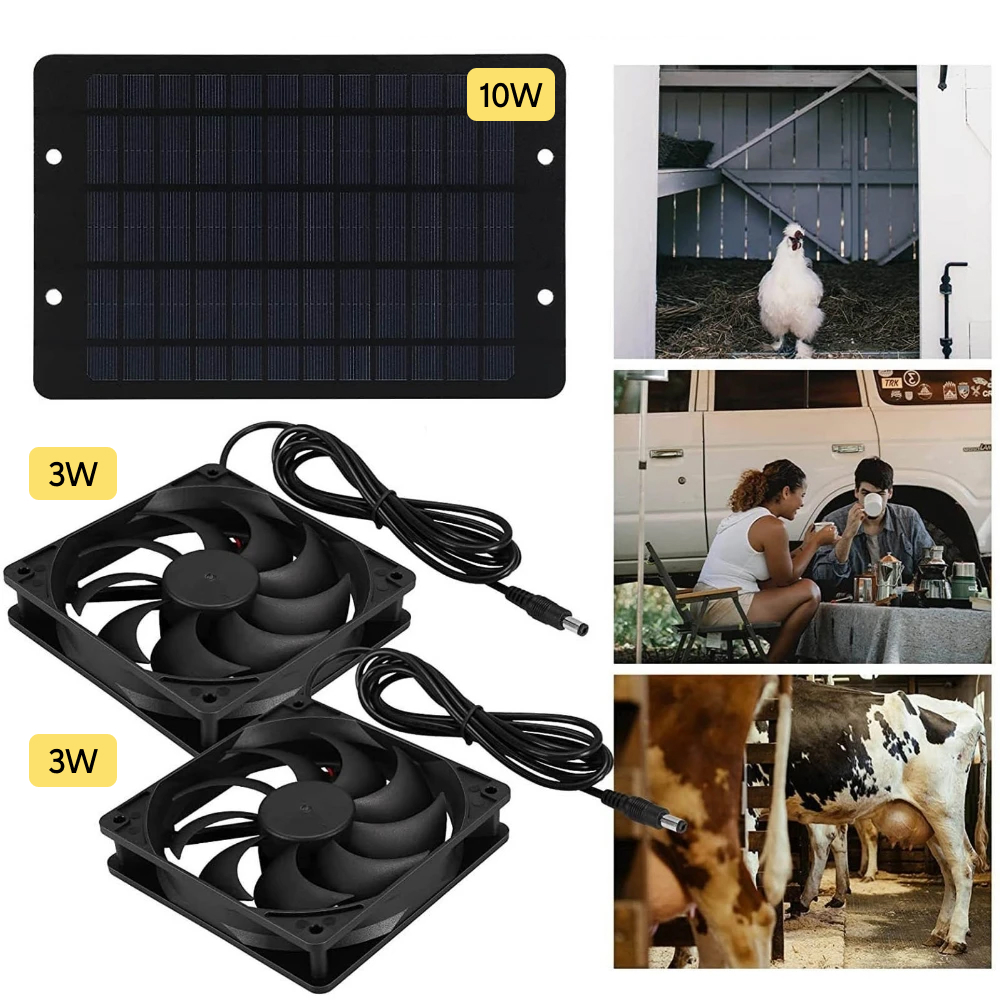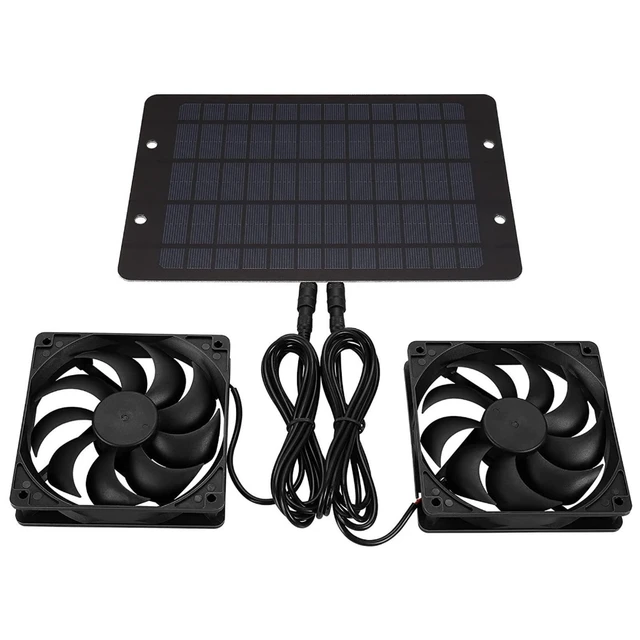Understanding The Technology Behind Solar Fans
Solar fans operate on a straightforward yet ingenious principle: converting sunlight into electrical energy to power a fan motor. This conversion is achieved through photovoltaic (PV) panels, which are typically installed on the roof or in a location with optimal sun exposure. The PV panels consist of multiple solar cells made from semiconductor materials, usually silicon. When sunlight hits these cells, it excites electrons, creating an electric current. This current is then harnessed to drive the fan, providing a steady airflow without relying on the grid. Advances in solar technology have led to significant improvements in the efficiency and affordability of these fans. Modern solar panels are capable of capturing more sunlight and converting it into usable energy even on cloudy days.
Top Solar Fans For Efficient Home Cooling
When it comes to selecting solar fans for home cooling, several top-rated models stand out due to their efficiency, durability, and ease of installation. Among these, the Amtrak Solar Attic Fan is highly regarded for its robust build and powerful performance. This fan features a high-efficiency motor and a large solar panel, making it capable of ventilating large attic spaces effectively. Another excellent option is the Natural Light Solar Attic Fan, known for its sleek design and superior airflow capacity. This fan is designed to withstand harsh weather conditions and comes with a 25-year warranty, ensuring long-term reliability. For those looking for a more versatile solution, the Broan-NuTone Solar-Powered Attic Ventilator offers both solar and electrical operation, providing flexibility in different weather conditions.

How Solar Fans Can Save You Money And Energy?
One of the most compelling reasons to invest in solar fans is their potential for significant cost and energy savings. Traditional cooling systems, such as air conditioners and electric fans, can consume a substantial amount of electricity, leading to high utility bills, especially during peak summer months. In contrast, solar fans utilize free and abundant solar energy, reducing the reliance on grid electricity and lowering energy costs. The initial investment in a solar fan can be offset by the savings on electricity bills over time. Additionally, many regions offer tax incentives and rebates for installing solar-powered devices, further reducing the overall cost. Beyond the financial benefits, solar fans also contribute to energy conservation and environmental protection.
Solar Fans VS Traditional Fans: A Comprehensive Comparison
When comparing solar fans to traditional fans, several key differences and advantages become evident. The most significant difference lies in the energy source: solar fans rely on renewable solar energy, while traditional fans typically depend on electricity from the grid. This reliance on solar power means that solar fans do not incur ongoing electricity costs, unlike their traditional counterparts. Moreover, solar fans are generally more environmentally friendly, as they do not produce greenhouse gas emissions during operation. In terms of performance, solar fans can be just as effective as traditional fans in providing ventilation and cooling, particularly in sunny regions where solar energy is abundant. However, traditional fans may have an edge in areas with limited sunlight or during nighttime use unless the solar fan is equipped with battery storage. Another factor to consider is maintenance.
Benefits Of Using Solar Fans In Your Home
There are numerous benefits to incorporating solar fans into your home. Firstly, they provide a renewable and eco-friendly cooling solution that reduces reliance on non-renewable energy sources. By utilizing solar power, these fans help lower electricity bills and contribute to energy conservation. Secondly, solar fans improve indoor air quality by providing continuous ventilation, reducing the buildup of heat, moisture, and pollutants. This is particularly beneficial in areas like attics, which can become extremely hot and stuffy without proper ventilation. Additionally, solar fans operate quietly, making them an excellent choice for residential settings where noise levels are a concern. They are also relatively easy to install and require minimal maintenance, adding to their convenience and cost-effectiveness.
Installing Solar Fans: A Step-By-Step Guide
Installing a solar fan can be a straightforward process, especially with the right tools and guidance. The first step is to determine the best location for the solar panel, typically on a roof or any area that receives maximum sunlight throughout the day. Once the location is chosen, the solar panel needs to be securely mounted using brackets or mounting hardware provided with the fan. Next, the wiring from the solar panel to the fan motor should be carefully connected, ensuring all connections are secure and weatherproof. For attic fans, this often involves cutting a hole in the roof or vent area to fit the fan. It’s crucial to follow the manufacturer’s instructions for both the solar panel and fan installation to ensure optimal performance and safety.
The Best Solar Fans For Outdoor Adventures
Solar fans are not only useful for home cooling but also a great addition to outdoor adventures. Whether you are camping, hiking, or enjoying a day at the beach, portable solar fans can provide much-needed relief from the heat. The best solar fans for outdoor use are lightweight, compact, and durable. The Ansee Solar Fan is a popular choice due to its portability and ability to charge via solar power or USB. It features a built-in LED light, making it useful for camping trips. Another excellent option is the Cowin Solar Fan, which offers multiple speed settings and a robust build to withstand outdoor conditions. For larger groups or longer trips, the Suaoki Collapsible.
Solar Fans: An Essential For Off-Grid Living
For those living off the grid, solar fans are an essential tool for maintaining comfort and sustainability. Off-grid living often involves reliance on renewable energy sources, and solar fans fit perfectly into this lifestyle by providing ventilation and cooling without the need for external power sources. They can help regulate indoor temperatures, prevent moisture buildup, and improve air quality in homes that are not connected to the traditional electrical grid. The Natural Light Solar Attic Fan and the Amtrak Solar Attic Fan are both excellent choices.
Conclusion
Solar fans represent a significant advancement in the quest for sustainable and efficient home cooling solutions. Their ability to harness renewable solar energy to provide ventilation and reduce indoor temperatures makes them an appealing option for environmentally conscious consumers. With numerous benefits, including cost savings, improved air quality, and reduced reliance on grid electricity, solar fans are becoming increasingly popular in both residential and outdoor settings. By understanding the technology behind these devices, exploring the top models available.

Fran Peters is a dedicated writer specializing in health and medical content. With a background in healthcare and a passion for helping others lead healthier lives, Fran brings a wealth of knowledge and expertise to her writing.















Post Comment